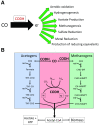Life on the fringe: microbial adaptation to growth on carbon monoxide
- PMID: 30647903
- PMCID: PMC6317499
- DOI: 10.12688/f1000research.16059.1
Life on the fringe: microbial adaptation to growth on carbon monoxide
Abstract
Microbial adaptation to extreme conditions takes many forms, including specialized metabolism which may be crucial to survival in adverse conditions. Here, we analyze the diversity and environmental importance of systems allowing microbial carbon monoxide (CO) metabolism. CO is a toxic gas that can poison most organisms because of its tight binding to metalloproteins. Microbial CO uptake was first noted by Kluyver and Schnellen in 1947, and since then many microbes using CO via oxidation have emerged. Many strains use molecular oxygen as the electron acceptor for aerobic oxidation of CO using Mo-containing CO oxidoreductase enzymes named CO dehydrogenase. Anaerobic carboxydotrophs oxidize CO using CooS enzymes that contain Ni/Fe catalytic centers and are unrelated to CO dehydrogenase. Though rare on Earth in free form, CO is an important intermediate compound in anaerobic carbon cycling, as it can be coupled to acetogenesis, methanogenesis, hydrogenogenesis, and metal reduction. Many microbial species-both bacteria and archaea-have been shown to use CO to conserve energy or fix cell carbon or both. Microbial CO formation is also very common. Carboxydotrophs thus glean energy and fix carbon from a "metabolic leftover" that is not consumed by, and is toxic to, most microorganisms. Surprisingly, many species are able to thrive under culture headspaces sometimes exceeding 1 atmosphere of CO. It appears that carboxydotrophs are adapted to provide a metabolic "currency exchange" system in microbial communities in which CO arising either abiotically or biogenically is converted to CO 2 and H 2 that feed major metabolic pathways for energy conservation or carbon fixation. Solventogenic CO metabolism has been exploited to construct very large gas fermentation plants converting CO-rich industrial flue emissions into biofuels and chemical feedstocks, creating renewable energy while mitigating global warming. The use of thermostable CO dehydrogenase enzymes to construct sensitive CO gas sensors is also in progress.
Keywords: CO dehydrogenase; carbon monoxide; extremophile.
Conflict of interest statement
No competing interests were disclosed.No competing interests were disclosed.No competing interests were disclosed.No competing interests were disclosed.
Figures

References
-
- Khalil MAK, Rasmussen RA: Carbon monoxide in the Earth's atmosphere: indications of a global increase. Nature. 1988;332:242–5. 10.1038/332242a0 - DOI
Publication types
MeSH terms
Substances
LinkOut - more resources
Full Text Sources

